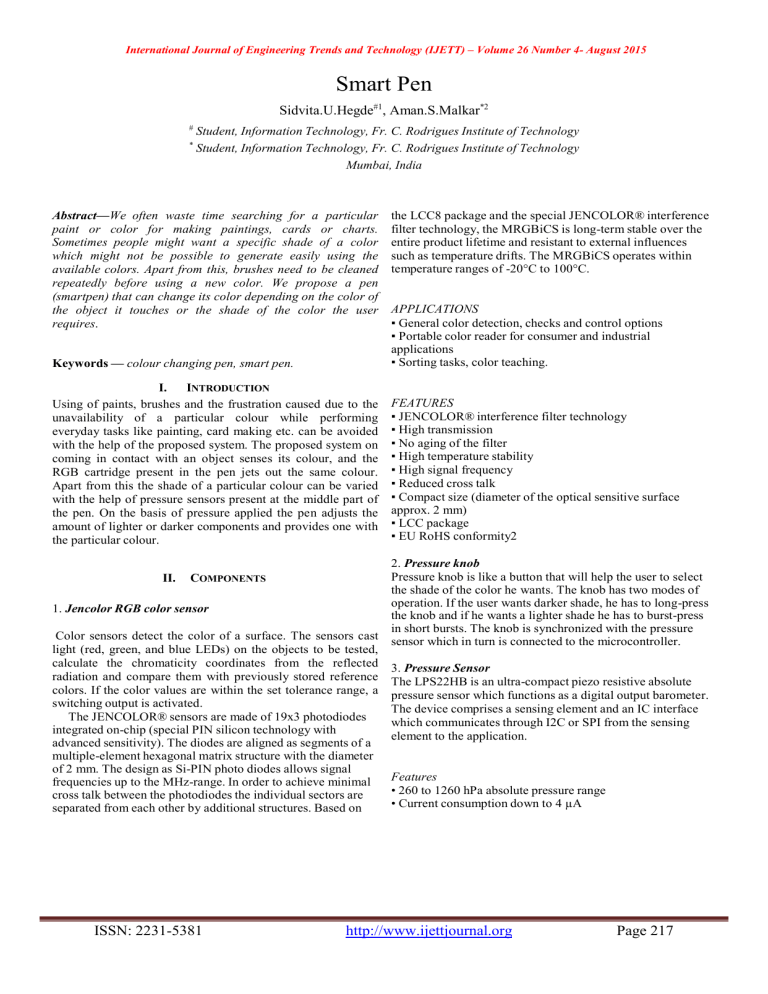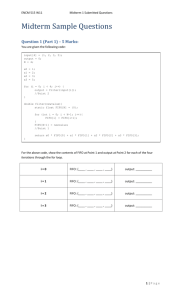Smart Pen

International Journal of Engineering Trends and Technology (IJETT) – Volume 26 Number 4- August 2015
Smart Pen
Sidvita.U.Hegde
#1
, Aman.S.Malkar
*2
# Student, Information Technology, Fr. C. Rodrigues Institute of Technology
* Student, Information Technology, Fr. C. Rodrigues Institute of Technology
Mumbai, India
Abstract— We often waste time searching for a particular paint or color for making paintings, cards or charts.
Sometimes people might want a specific shade of a color which might not be possible to generate easily using the available colors. Apart from this, brushes need to be cleaned repeatedly before using a new color. We propose a pen
(smartpen) that can change its color depending on the color of the object it touches or the shade of the color the user requires .
Keywords — colour changing pen, smart pen.
I. I NTRODUCTION
Using of paints, brushes and the frustration caused due to the unavailability of a particular colour while performing everyday tasks like painting, card making etc. can be avoided with the help of the proposed system. The proposed system on coming in contact with an object senses its colour, and the
RGB cartridge present in the pen jets out the same colour.
Apart from this the shade of a particular colour can be varied with the help of pressure sensors present at the middle part of the pen. On the basis of pressure applied the pen adjusts the amount of lighter or darker components and provides one with the particular colour.
II. C OMPONENTS
1. Jencolor RGB color sensor
Color sensors detect the color of a surface. The sensors cast light (red, green, and blue LEDs) on the objects to be tested, calculate the chromaticity coordinates from the reflected radiation and compare them with previously stored reference colors. If the color values are within the set tolerance range, a switching output is activated.
The JENCOLOR® sensors are made of 19x3 photodiodes integrated on-chip (special PIN silicon technology with advanced sensitivity). The diodes are aligned as segments of a multiple-element hexagonal matrix structure with the diameter of 2 mm. The design as Si-PIN photo diodes allows signal frequencies up to the MHz-range. In order to achieve minimal cross talk between the photodiodes the individual sectors are separated from each other by additional structures. Based on the LCC8 package and the special JENCOLOR® interference filter technology, the MRGBiCS is long-term stable over the entire product lifetime and resistant to external influences such as temperature drifts. The MRGBiCS operates within temperature ranges of -20°C to 100°C.
APPLICATIONS
▪ General color detection, checks and control options
▪ Portable color reader for consumer and industrial applications
▪ Sorting tasks, color teaching.
FEATURES
▪ JENCOLOR® interference filter technology
▪ High transmission
▪ No aging of the filter
▪ High temperature stability
▪ High signal frequency
▪ Reduced cross talk
▪ Compact size (diameter of the optical sensitive surface approx. 2 mm)
▪ LCC package
▪ EU RoHS conformity2
2. Pressure knob
Pressure knob is like a button that will help the user to select the shade of the color he wants. The knob has two modes of operation. If the user wants darker shade, he has to long-press the knob and if he wants a lighter shade he has to burst-press in short bursts. The knob is synchronized with the pressure sensor which in turn is connected to the microcontroller.
3. Pressure Sensor
The LPS22HB is an ultra-compact piezo resistive absolute pressure sensor which functions as a digital output barometer.
The device comprises a sensing element and an IC interface which communicates through I2C or SPI from the sensing element to the application.
Features
• 260 to 1260 hPa absolute pressure range
• Current consumption down to 4 µA
ISSN: 2231-5381 http://www.ijettjournal.org
Page 217
International Journal of Engineering Trends and Technology (IJETT) – Volume 26 Number 4- August 2015
• High overpressure capability: 20x full-scale
• Embedded temperature compensation
• 24-bit pressure data output
• 16-bit temperature data output
• ODR from 1 Hz to 75 Hz
• SPI and I²C interfaces
• Embedded FIFO
•Interrupt functions: Data Ready, FIFO flags, pressure thresholds
• Supply voltage: 1.7 to 3.6 V
• High shock survivability: 22,000 g
• Small and thin package
• ECOPACK® lead-free compliant
Functionality
The LPS22HB is a high resolution, digital output pressure sensor packaged in an HLGA full mold package. The complete device includes a sensing element based on a piezo resistive, Wheatstone bridge approach, and an IC interface which communicates a digital signal from the sensing element to the application.
Sensing element
An ST proprietary process is used to obtain a silicon membrane for MEMS pressure sensors. When pressure is applied, the membrane deflection induces an imbalance in the
Wheatstone bridge piezo resistances whose output signal is converted by the IC interface.
I2C interface:
The complete measurement chain is composed of a low-noise amplifier which converts the resistance unbalance of the
MEMS sensors (pressure and temperature) into an analog voltage using an analog-to-digital converter. The pressure and temperature data may be accessed through an I²C/SPI interface thus making the device particularly suitable for direct interfacing with a microcontroller. The LPS22HB features a Data-Ready signal which indicates when a new set of measured pressure and temperature data are available, thus simplifying data synchronization in the digital system that uses the device.
Factory calibration
The IC interface is factory calibrated at three temperatures and two pressures for sensitivity and accuracy. The trimming values are stored inside the device in a non-volatile structure.
When the device is turned on, the trimming parameters are downloaded into the registers to be employed during the normal operation which allows the device to be used without requiring any further calibration.
Working mode :
FIFO-
The LPS22HB embeds a 32-slot of 40-bit data FIFO to store the pressure and temperature output values. This allows consistent power saving for the system, since the host processor does not need to continuously poll data from the sensor, but it can wake up only when needed and burst the significant data out from the FIFO. This buffer can work according to seven different modes: Bypass mode, FIFO mode, Stream mode, Dynamic Stream mode, Stream-to-FIFO mode, Bypass-to-Stream and Bypass-to-FIFO mode. The
FIFO buffer is enabled when the FIFO_EN bit in
CTRL_REG2 (11h) is set to '1' and each mode is selected by the FIFO_MODE[2:0] bits in FIFO_CTRL (14h).
Programmable FIFO threshold status, FIFO overrun events and the number of unread samples stored are available in the
FIFO_STATUS (26h) register and can be set to generate dedicated interrupts on the INT_DRDY pad using the
CTRL_REG3 (12h) register. FIFO_STATUS(FTH_FIFO) goes to '1' when the number of unread samples
(FIFO_STATUS(FSS5:0)) is greater than or equal to
WTM[4:0] in FIFO_CTRL (14h). If FIFO_CTRL(WTM4:0) is equal to 0, FIFO_STATUS(FTH_FIFO) goes to '0'.
FIFO_STATUS(OVRN) is equal to '1' if a FIFO slot is overwritten. FIFO_STATUS(FSS5:0) contains stored data levels of unread samples; when FSS[5:0] is equal to '000000'
FIFO is empty, when FSS[5:0] is equal to '100000' FIFO is full and the unread samples are 32. To guarantee the switching into and out of FIFO mode, discard the first sample acquired.
Fig. 1 Spectrum Characteristic of RGB sensor
ISSN: 2231-5381 http://www.ijettjournal.org
Page 218
International Journal of Engineering Trends and Technology (IJETT) – Volume 26 Number 4- August 2015
Features:
-16GB flash memory
-6-20V unregulated power supply
-Each of the 14 digital pins on the Nano can be used as an input or output.
4. RGB color cartridge
The RGB color cartridge will form the color as directed by the
<microcontroller> depending on the input of the color sensor.
The user can further change the shade of the color depending on their need (dark/light) with the help of the pressure knob.
The pressure knob is connected to the pressure sensor which allows the precise shade to be selected. Darker shades are obtained by mixing black color with the current color selection and brighter shades are obtained by mixing white with the current color.
5 . ESP8266 wifi module
ESP8266 is an impressive, low cost WiFi module suitable for adding WiFi functionality to an existing microcontroller project via a UART serial connection. The module can even be reprogrammed to act as a standalone WiFi connected device–just add power! The feature list is impressive and includes: 802.11 b/g/n protocol Wi-Fi Direct (P2P), soft-AP
Integrated TCP/IP protocol stack.
6. Arduino Nano
The Arduino Nano is a small, complete, and breadboard- friendly board based on the ATmega328 (Arduino Nano 3.x) orATmega168 (Arduino Nano 2.x). It has more or less the same functionality of the Arduino, but in a different package.
It lacks only a DC power jack, and works with a Mini-B USB cable instead of a standard one.
Fig. 2 Arduino Nano
III. W ORKING
A color sensor is present at the apex of the pen. When this comes in contact with an object, it detects the color. This analog value is then sent to a microcontroller which converts it into a digital value. The value from the microcontroller is sent to the system using the wifi module embedded into it.
The value is then compared with the already existing values.
On finding a match, the same RGB value is used to inject the specific ink.
A pressure sensor is present as show in the figure. Based on the pressure applied the color changes shade. The value from the pressure sensor is sent to the Arduino and based on the value, it is either darkened by mixing black ink or lightning it by mixing white ink.
Fig. 3 Proposed Model of Smart Pen
ISSN: 2231-5381 http://www.ijettjournal.org
Page 219
International Journal of Engineering Trends and Technology (IJETT) – Volume 26 Number 4- August 2015
IV. C ONCLUSION
In this paper, we have proposed an enhancement to the traditional pen. The pen prototype, if implemented, could be useful for various purposes. People would not have to waste time to clean their brush or to find a color or spend time trying to mix various colors to obtain a particular shade. This pen can be carried along to scan whichever color we like or intend to use and start writing or painting along, without having to look for a brush or a color palette.
R EFRENCES
[1] http://rancidbacon.com/files/kiwicon8/ESP8266_WiFi_Module_Quick
_St art_Guide_v_1.0.4.pdf
[2] http://rancidbacon.com/files/kiwicon8/ESP8266_WiFi_Module_Quick_St art_Guide_v_1.0.4.pdf
[3] http://www.reichelt.de/Einplatinen-Microcontroller/ARDUINO-
NANO/3/index.html?ACTION=3&GROUPID=6667&ARTICLE=142
943&OFFSET=16&SID=10VRpVJ6wQATIAAE7hKjY4be7138985d0c3ab
092f2a5c887a28ab&LANGUAGE=EN
[4] http://www.sick.com/group/EN/home/products/product_portfolio/regist rationsensors/Pages/colour_sensors.aspx
[5] http://www.mazet.de/en/products/jencolor/rgb-sensors
[6] http://www.st.com/st-web- ui/static/active/en/resource/technical/document/datasheet/DM00140895.pdf
[7]Ch Srikanth, D S Pradeep M and Sreeram Charan K, "Smart Embedded
Medical Diagnosis using Beaglebone Black and Arduino" International
Journal of Engineering Trends and Technology (IJETT),Volume.8,No.1,pp.
43-48,Feb 2014.
ISSN: 2231-5381 http://www.ijettjournal.org
Page 220






